First Grade Open House includes exhibits on Rock Creek Park’s History, Flora, and Fauna and Presentation of Original Hebrew Stories
February 2, 2017 by
Last week, First Graders exhibited their expertise and creativity at their first Bayit Patuach (Open House) of the year, showcasing models of historic structures built from recycled materials, curated writing portfolios, multimedia representations of animal habitats, and clay sculptures of various plant species. Throughout the first semester, First Grade students explored the theme “Encounters with the Natural World,” with each class engaging in an in-depth study of a specific aspect of Rock Creek Park.
The Zaytim Class studied the flora and fauna of Rock Creek Park. Each student chose an animal to research, write about, draw and sculpt. They used books and internet resources to conduct research about their animal’s appearance, habitat, diet, family, and other interesting facts. Then, each child completed a research book with brief compositions about each topic relating to their animal. Students then worked in collaborative groups to create habitats out of recycled materials for groups of similar animals. This endeavor helped students represent their learning in a new way, while also showcasing all the details they had learned about the habitats in which their animals lived. They also created a class book of animal fantasy stories, using skills they learned during their Reading block. The Hadasim Class investigated the problems and challenges facing the park. Students learned about the consequences of pollution and littering. They also learned about native and non-native species. As a class, they came up with the following definition: “Non-native, invasive plants are plants that don’t belong here. They take over too much space and they block out the sun and drink up water.” Students learned about Kudzu, English Ivy, Garlic Mustard, and Mile-a-Minute plants. They wrote about non-native plants and explained that the plants can have a negative impact on local horticulture. Students made a sketch of their plant and then created a clay sculpture of it. Students referenced their sketches when working with clay, ultimately painting the clay in realistic tones. The Tainim Class researched the historical landmarks of the park, including Pierce Mill, the Stone House, the Joaquin Miller Cabin, and Fort Stevens. They learned why each landmark was built and the historical purpose it served. Students used photographs of these landmarks to build replicas out of recycled materials. They made sure that their models were to scale, tying in math skills. After discussing how landmarks represent important time periods or parts of history, they also used clay to create landmarks that were representative of their own lives.
Students proudly toured their parents and guests, sharing their individual work such as compositions and clay pieces, as well the collaborative multi-media group presentations. Students also had an opportunity to share their Hebrew skills. The children read original stories about animals—all in Hebrew! Students had written, revised, and practiced reading these pieces during Hebrew and Judaic Studies. Finally, both parents and children were invited to design a ceramic tile to represent their family’s relationship and encounters with nature. Together, they used painting to express themselves in one of the “hundred languages” in which children learn. The tiles are vibrant and beautiful, and will soon be on display on South Campus as a mosaic.
The students loved sharing their learning with their families at the Bayit Patuach. Shortly after it ended, they asked, “What are we going to do for our next Bayit Patuach?”






